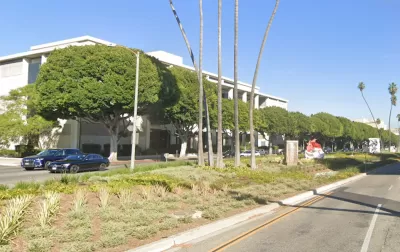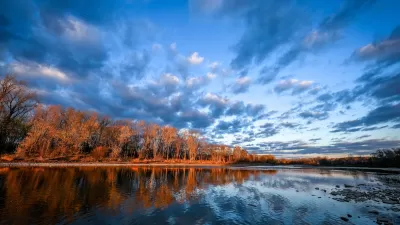A three-block median featuring native plants and bioswales is part of the city’s broader effort to reduce water consumption and pollution.

A three-block median in Beverly Hills is thriving as the city’s first ‘green street,’ just in time for this month’s unusually wet weather. As Tabor Brewster reports in Beverly Press, “The Burton Way green street and water efficient landscape project is in the final stages of testing and is set to officially open at a ribbon-cutting ceremony at Rexford Mini Park on Wednesday, Feb. 28, at 11 a.m.”
The project is expected to reduce water pollution and water consumption by collecting rainwater and runoff. “According to environmental compliance and sustainability program manager Josette Descalzo, the project features a storm drain that will divert water – from both rain and excess irrigation – into the median on Burton Way. From there, the water will be filtered by two 15-foot-wide vegetated channels also known as bioswales.”
According to Mayor Julian Gold, the city plans to install more similar projects to meet its sustainability goals. “[California] emergency water regulations also require Beverly Hills to reduce its water consumption by 32%, and this project will save about 5 million gallons of water annually, according to the city.”
FULL STORY: City’s first ‘green street’ blossoms on Burton Way

Manufactured Crisis: Losing the Nation’s Largest Source of Unsubsidized Affordable Housing
Manufactured housing communities have long been an affordable housing option for millions of people living in the U.S., but that affordability is disappearing rapidly. How did we get here?

Americans May Be Stuck — But Why?
Americans are moving a lot less than they once did, and that is a problem. While Yoni Applebaum, in his highly-publicized article Stuck, gets the reasons badly wrong, it's still important to ask: why are we moving so much less than before?

Using Old Oil and Gas Wells for Green Energy Storage
Penn State researchers have found that repurposing abandoned oil and gas wells for geothermal-assisted compressed-air energy storage can boost efficiency, reduce environmental risks, and support clean energy and job transitions.

Updating LA’s Tree Rules Could Bring More Shade to Underserved Neighborhoods
A new USC study finds that relaxing Los Angeles’ outdated tree planting guidelines could significantly expand urban tree canopy and reduce shade disparities in lower-income neighborhoods, though infrastructure investments are also needed.

California's Canal Solar Projects Aim to Conserve Resources and Expand Clean Energy
California’s Project Nexus has begun generating electricity from solar panels installed over irrigation canals, with researchers and state agencies exploring statewide expansion to conserve water and boost clean energy production.

HHS Staff Cuts Gut Energy Assistance Program
The full staff of a federal program that distributes heating and cooling assistance for low-income families was laid off, jeopardizing the program’s operations.
Urban Design for Planners 1: Software Tools
This six-course series explores essential urban design concepts using open source software and equips planners with the tools they need to participate fully in the urban design process.
Planning for Universal Design
Learn the tools for implementing Universal Design in planning regulations.
Heyer Gruel & Associates PA
City of Moreno Valley
Institute for Housing and Urban Development Studies (IHS)
City of Grandview
Harvard GSD Executive Education
Salt Lake City
NYU Wagner Graduate School of Public Service
City of Cambridge, Maryland




























